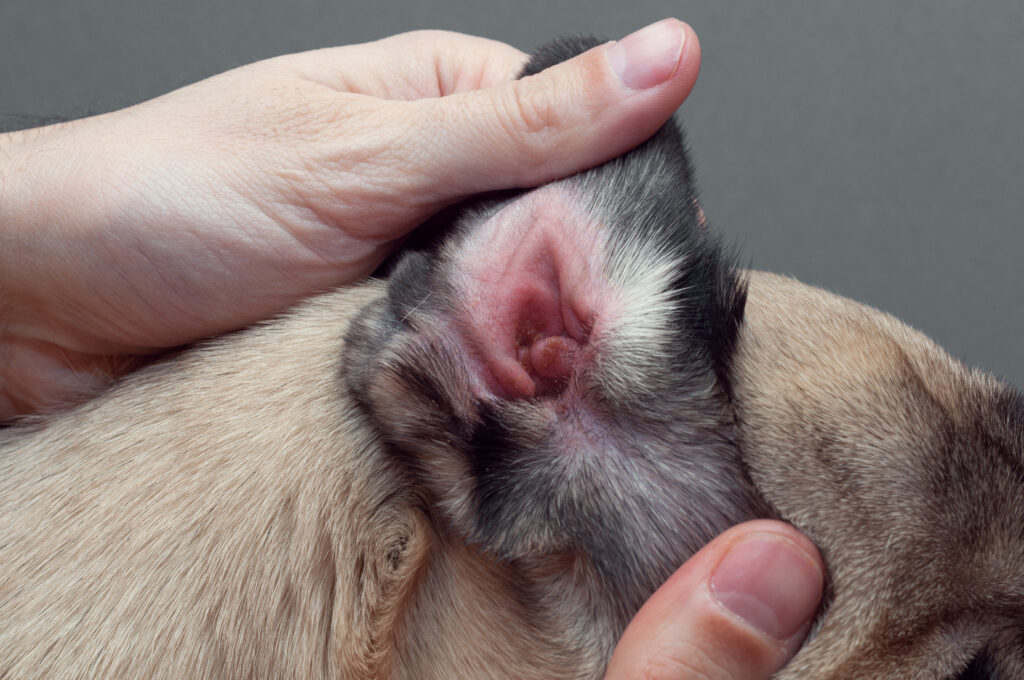What are Dog Mites?
You may have heard of dust mites, but do you know about dog mites? Ensuring your pet’s health and happiness is a goal we share with you, which is why we want to help you better understand the problem of dog mites and the many health issues they can cause in our canine friends. While we’re happy to provide valuable insights in our blog, we are also dedicated to providing personalized care for your pet and trusted advice for you. You can always reach out to Little Silver Animal Hospital at (732) 842-8266 – we’re here to help!
What Types of Dog Mites are Out There?
Mites, tiny arachnids related to ticks and spiders, can cause all kinds of problems in dogs. It’s important to distinguish between the different types to address the specific issues they may bring.
Demodex Mites
Demodex mites, often referred to as “follicle mites,” inhabit the hair follicles and sebaceous glands. They are typically harmless in small numbers but they can multiply and cause Demodectic mange, a skin condition that results in hair loss, redness, and itching in dogs.
Sarcoptic Mites
Sarcoptic mites, also known as scabies mites, are highly contagious. They burrow into the top layer of a dog’s skin, causing intense itching, hair loss, and skin inflammation. These mites can quickly spread between dogs, making early detection and treatment essential.
Ear Mites
Ear mites, scientifically known as Otodectes cynotis, primarily infest a dog’s ears. While not life-threatening, they can cause quite a bit of discomfort, leading to itching, head shaking, and ear inflammation. Ear mites are relatively common in dogs, especially dogs with floppy ears.
How Do Dogs Get Mites?
Understanding how dogs can become infected with mites is the first step in preventing these pesky parasites from wreaking havoc on your pet. Mites can be transmitted through various means, including:
Direct Contact
The most common mode of mite transmission is direct contact with an infected dog. Playing, grooming, or interacting with an infested dog can transfer mites from one to another.
Environment
Mites can also survive in the environment, such as in bedding, carpets, and upholstery. If your dog frequents these areas, they might pick up mites from contaminated surfaces.
Mother to Pup
Puppies can contract Demodex mites from their mother while they are nursing. Fortunately, this condition often resolves on its own as the puppy’s immune system matures.
The Effects of Dog Mite Infestations
Each type of mite infestation comes with its own set of problems, with discomfort being the common denominator. Demodex mites, if left untreated, can cause severe skin issues and discomfort for your dog. Sarcoptic mites can cause intense itching of the skin, which may result in stubborn skin infections due to your pet’s excessive scratching. Ear mite infestations often result in ear inflammation, which, in addition to being uncomfortable, can also lead to further complications if left untreated.
Signs Your Dog May Have Mites
If you want to minimize your dog’s discomfort, it’s important to know the signs of a mite infestation so you can act quickly and intervene before the situation worsens.
Common signs and symptoms of dog mite infestations include:
- Itching and scratching
- Hair loss
- Redness and inflammation
- Crusty or scaly skin
- Ear shaking and head tilting (for ear mites)
- Excessive earwax and odor (for ear mites)
If you notice any of these signs, contact Little Silver Animal Hospital to schedule an appointment for your pet.
Diagnosing and Treating Dog Mites
If you suspect a mite infestation in your dog, seek professional help as soon as possible. We can diagnose mites through skin scrapings, ear swabs, or other appropriate tests.
Treatment options may include topical medications, oral medications, antibiotics, and/or injections, depending on the severity of the infestation and the type of mite involved. Some dogs may develop a secondary skin infection due to scratching and licking at their skin in a futile bid to relieve their itching.
How to Prevent a Dog Mite Infestation
To protect your dog from menacing mites, take these preventative measures:
- Commit to regular grooming and bathing appointments
- Clean and disinfect your dog’s living area regularly
- Avoid coming into contact with potentially infested dogs
- Monitor your dog’s skin and ears for any changes (redness, inflammation, hair loss, etc.)
- Schedule routine checkups with your veterinarian
By following these steps, you can reduce the risk of mite infestations and keep your canine companion healthy and comfortable.
Contact Us for More Information About Dog Mites
Understanding the various types of dog mites, how dogs contract them, and the associated problems that come with these infestations can help prepare you for potential issues later down the road. If you suspect a mite infestation or have any concerns about your dog’s health, call Little Silver Animal Hospital today at (732) 842-8266 for expert guidance and care tailored to your canine family member’s needs.





